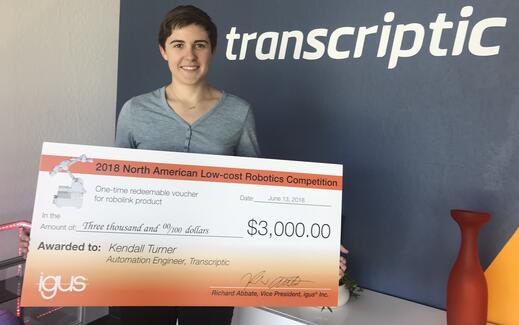Low Cost Robotics - A Win For Science And Transcriptic
Low cost robotics (LCR) is a rapidly growing field that regularly augments our work at Transcriptic...

Low cost robotics (LCR) is a rapidly growing field that regularly augments our work at Transcriptic. By sharing our capabilities with cloud-connected users in a cost-effective way, we democratize the productivity and reproducibility gains that come from automating complex scientific tasks without the need to spend millions of dollars on equipment, allowing researchers to pay only for what they use.
Low Cost Robotics (LCR)
Low cost robotics utilizes common, modular components to create automated systems that are suited to the task at hand for minimal unnecessary expense. Due to its modularity, when requirements change, these systems can be upgraded for low marginal cost to enable new functionality. At Transcriptic, we augment our custom-built biology workcells with low cost robotics and build low level communication to enable LCR to deeply integrate with our software infrastructure.
The LCR Innovation Competition
Outside of our automated workcells, there are still tasks that humans must perform due to their complexity or issues with device interoperability. When the opportunity to apply to the Igus 2018 North American Low Cost Robotics Innovation Competition arose, I jumped at the chance to demonstrate how low cost robotics could move out of the workcells and onto the lab bench.
The Problem
For this competition, I described how lab automation devices are most often optimized to handle labware formats that conform to the standard set forth by the Society for Biomolecular Screening (SBS). Adhering to this standard allows lab automation devices to be integrated into high throughput automated systems. However, libraries of synthesized reagents are still often stored in capped storage tubes and interacting with these tubes is a necessary first step to many otherwise automated workflows. It is only specialized devices that can handle these tubes because the interaction, including capping and decapping, is more complex, and the small size of the tube is not compatible with transport systems designed to handle SBS format labware. Devices that can rearray tubes cost around $25,000, and those that can cap and decap as well as liquid handle cost in excess of $50,000. This is a sizable investment for smaller labs with dynamic protocol needs. To optimize cost versus device usage, labs must utilize modular, low cost automation lines that can be easily re-configured to provide the most value for their capital expenditure.
The Solution
A low cost robotic arm can take the place of a specialized tube handling device by being the link between devices that labs already use during tube-based processes. Typical workflows utilizing tubes generally contain a number of operations. To begin, the tubes are taken out of storage in SBS format racks and rearrayed so that a rack contains only the tubes needed for the workflow in the proper order for liquid handling. The tubes are then decapped, liquid handled, and re-capped for storage. Tubes also may be transported to a vortex mixer before or after liquid handling to ensure the mixture is homogeneous or a centrifuge to concentrate liquids towards the bottom. A scientist can perform all of these operations without issue but the workflow is harder for a standard lab robot that is designed to only handle plates.
The existing solution for automating this sequence is to store tubes in SBS formatted racks and utilize a standard lab robot with an SBS format sized gripper to transport the rack to a dedicated device equipped for tube handling and rearraying. Once the tubes are re-arrayed, the lab robot takes the destination rack to be liquid handled or manually mixed. These limitations result in time lost in transportation and reduced flexibility for the devices which can be integrated into the workflow. A low cost robot arm with a tube handling gripper, however, would be able to take in one or more racks of tubes, rearray the tubes, remove caps, replace caps, and even transfer tubes to a non-SBS compatible vortex mixer or liquid handler that the lab already owns. Additionally, a more flexible arm could place individual tubes into into existing benchtop devices that are not designed for SBS compatible use. This approach utilizes existing laboratory technology and requires less capital than it would take to buy a dedicated tube handling device. As an added benefit when protocols change, the modular pieces of the system can be re-tasked to other workflows or other device sets.
I Won!
Modularity and flexibility are guiding principles for Transcriptic as we strive to create the Lab of the Future. The philosophy of LCR resonates with our efforts to democratize science. Being awarded the Igus Innovation competition prize is a recognition of the value and impact that LCR can have on biotechnology. Winning the competition comes with an Igus Robolink® system as a prize. Transcriptic is deeply committed to pushing the boundaries of science through automation backed by our software platform and Autoprotocol. We will use the system along with other technologies to further democratize robust and reproducible science.
